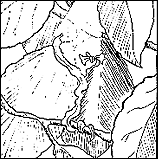
Not only are they more efficient, but puffers can save farmers labor and money. They can be placed 10 per side of a 40 acre block, rather than 100-400 per acre for ties or membranes. They are also placed lower on a tree, making them easier to hang. Since fewer puffers are needed per acre, they may soon compete in price with conventional sprays.
Farmers who cannot rely on mating disruption due to geography of their orchard, however, still have an arsenal of other biological weapons at their disposal. Parasites of coddling moth eggs in the form of wasps, worms, bacteria, or virus can be sprayed to kill off eggs before they hatch. Any of these can be used alone, or as a supplement to pheromones. "All techniques work well, if you understand the dynamics and biology of your orchard," said Loyal.